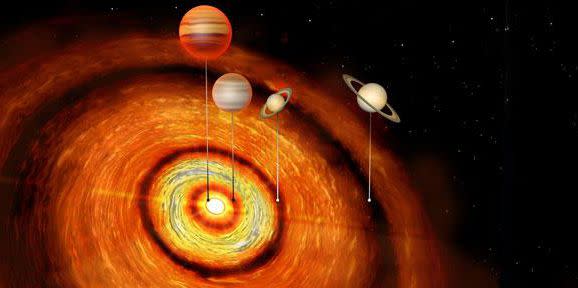In a Cosmic First, Scientists Discover Four Giant Planets Orbiting Newborn Star

Scientists have discovered thousands of planets orbiting other stars, so it takes a particularly exciting discovery to make discovering a new planet stand out. A recent announcement, however, might just meet that threshold: scientists found four gigantic planets orbiting around a newborn star, in a cosmic first.
The star in question is called CI Tau, and lies around 500 light-years away from our own solar system. The star is around 2 million years old, which makes it practically a baby. In comparison, our own star is nearly 5 billion years old. CI Tau is so young that the material around it hasn’t finished forming into planets; instead, that material forms a disk of dust and gas around the star called a protoplanetary disk.
Eventually, that disk will almost completely clump into planets like our solar system. Right now CI Tau is only home to four planets, but those planets are all enormous. Two are bigger than Jupiter, and the other two are about the same size as Saturn. The innermost planet is actually one of the biggest planets ever discovered, about ten times the size of Jupiter.
These planets carve gaps in the star’s protoplanetary disk where they orbit, and those gaps are visible with a telescope. That’s how researchers at the Atacama Large Millimeter/submillimeter Array (ALMA) radio telescope in Chile managed to find these giant planets. They spotted four gaps in CI Tau’s disk, each corresponding to one of the star’s gas giants.
Surprisingly, the astronomers noticed that the Saturn-sized planets were located very far from their star; the furthest is more than twice as far away as Pluto is from our Sun. At that distance, Saturn-sized planets should take a very long time to form, which is why it’s so strange to find two of them orbiting such a young star.
“Saturn mass planets are supposed to form by first accumulating a solid core and then pulling in a layer of gas on top, but these processes are supposed to be very slow at large distances from the star,” said study author Cathie Clarke. “Most models will struggle to make planets of this mass at this distance.”
Now that these planets have been officially discovered, scientists can study them further to learn more about how these types of planets form. That can tell us more about how our own solar system developed.
Source: University of Cambridge via Space.com
('You Might Also Like',)
